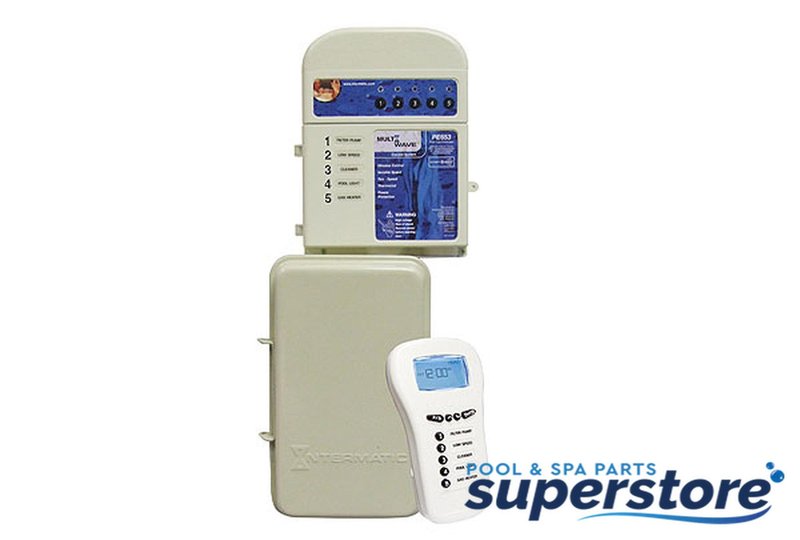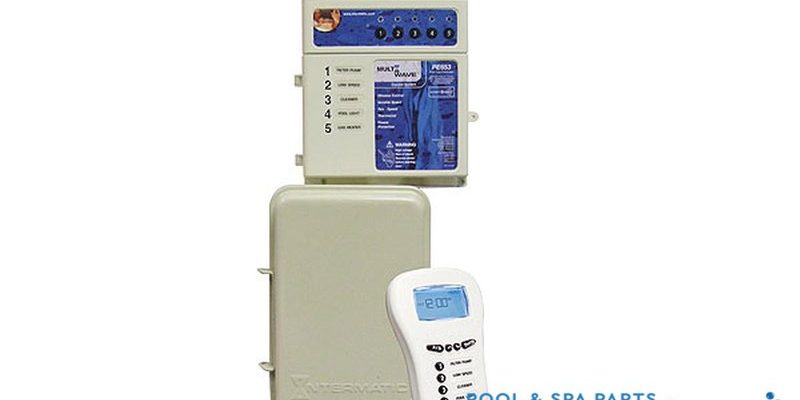
Here’s the thing: the Intermatic pool remote (think PE953, PE953RC, or their cousins) is like the universal remote for your pool life—controlling pumps, lights, heaters, you name it. They’re handy, but just like that one stubborn smartphone we all know, sometimes the screen decides to freeze up. It’s not the end of the world, but it sure is annoying when you’re ready for a swim or just want to get those backyard vibes going.
So, why does your Intermatic pool remote suddenly ignore you like an angry cat? Let’s break down what’s really going on, why these issues happen, and—most importantly—how you can get things rolling again without calling in a professional immediately.
Common Reasons Your Intermatic Pool Remote Screen Freezes
When your Intermatic pool remote screen freezes, it’s usually trying to tell you something—even if it’s doing it in the most unhelpful way possible. In my experience, most cases come down to a handful of usual suspects, and honestly, they’re the same kinds of problems you’d see in any other electronic remote.
First up: battery troubles. You might be surprised how often a dying battery or bad battery connection can lock up that screen. If the voltage drops too low, the device can get sort of “stuck” in the middle of its last command. Sometimes, popping out the batteries for a minute and putting them back in is enough to *unfreeze* things.
Next, software glitches happen. Remember, your Intermatic remote is basically a mini-computer. Its onboard code can hit a snag if something goes wrong during communication with the pool panel, especially after a power outage or interrupted pairing process. This can lead to the screen freezing on the last displayed info, or just going totally blank.
Physical damage is another culprit. Dropping the remote, getting it too wet, or leaving it in direct sunlight a little too long can all mess with the internal circuits. Even if the outside looks okay, a little water inside or a broken contact can make the screen and buttons totally unresponsive.
Finally, interference or lost connection with the main pool controller can cause issues. If the remote can’t sync up or pair successfully—say, because you’re too far from the receiver, or there’s a wall in the way—it might freeze instead of throwing an error message. The screen just gets stuck because it doesn’t know what else to do.
How The Intermatic Pool Remote Communicates With Your Pool System
Let me explain how these remotes actually work, because understanding the basics makes troubleshooting a whole lot less mysterious. The Intermatic pool remote (like the PE953) communicates wirelessly with a base receiver connected to your pool equipment. Think of it like walkie-talkies—your remote is one, the pool control panel is the other.
When you press a button, the remote sends out a coded radio signal. This signal tells your pool’s receiver what you want—turn on the heater, start the pump, change the light color, and so on. If everything’s working, the receiver sends back a confirmation, and your remote updates its display.
The tricky part? If the signal pathway gets scrambled—maybe from interference, a drained battery, or distance—the remote can freeze up waiting for a reply that never comes. It’s basically sitting there, mid-conversation, with no idea what to do next.
Here’s a quick analogy: imagine texting a friend, but your phone loses service right as you hit send. Your message just hangs there, unsent. That’s a lot like what happens when your Intermatic remote loses contact with its base station.
Coding and sync issues can also cause problems—if you recently tried to pair a new remote, or switch control panels, sometimes the devices get confused and lock up. Resetting or re-pairing can often clear up these digital misunderstandings.
Battery and Power Issues: The Most Overlooked Cause
You might be wondering, “Can a battery really cause all this drama?” Absolutely. Batteries aren’t just a power supply—they’re the lifeblood of your Intermatic remote. When they start to run low, the remote can act in all sorts of weird ways, and a frozen screen is just one of them.
Here’s how it happens: as batteries lose their charge, the voltage dips below what the remote’s microchip expects. Suddenly, things start to slow down. Maybe the display flickers, or the buttons lag—or everything just stops. Sometimes, even brand new batteries won’t work if they’re not seated correctly or if there’s a bit of corrosion on the contacts.
Pro tip: Remove the battery cover, take the batteries out, and look for any rust or powdery gunk. Wipe it gently with a dry cloth or a cotton swab (avoid anything wet), then pop in fully fresh batteries. If you have a multimeter handy, you can check the voltage too—any reading below 1.2V per cell, and it’s time to replace.
Also, remember that some Intermatic pool remotes use *special* batteries (like coin cells) instead of standard AAs or AAAs. Make sure you’re using the right size and type, and don’t mix old and new batteries.
If you get things back up and running after a battery swap, you’ve just saved yourself a service call.
What To Do If Your Intermatic Remote Screen Is Frozen
So, your Intermatic pool remote screen is stuck. What now? Don’t panic—there are a couple of steps you can try before throwing in the towel.
- Step 1: Power cycle. Take out the batteries. Wait 30–60 seconds (long enough to hum the Jeopardy! theme if you need a timer), then put them back in. This simple reset clears most minor glitches.
- Step 2: Check the battery contacts. Give those little metal bits inside the battery compartment a gentle wipe to remove any corrosion or residue.
- Step 3: Try a “hard reset.” On some Intermatic remotes, you can hold down the power or “reset” button while reinserting the batteries. (Look for a tiny pinhole or a labeled button.) Check your device’s manual for the exact steps, but a hard reset often solves stubborn freezes.
- Step 4: Re-sync or re-pair. If the remote was recently disconnected or replaced, it might need to be re-synced with the pool receiver. This typically involves pressing a “Learn” button on the pool control panel, then following pairing instructions on the remote’s screen—once it’s working again, of course.
If none of these steps help, don’t force the buttons or open up the remote—internal repairs are usually best left to a professional, unless you’re feeling especially brave (and have a backup).
You might also try moving closer to the pool panel, or away from sources of interference (like Wi-Fi routers). Sometimes, just reducing the distance can restore the signal and unfreeze the display.
Dealing With Software Glitches And Firmware Issues
Sometimes, the cause isn’t physical at all—it’s digital. Software bugs and outdated firmware can trip up these remotes, especially after power surges or if you’ve recently updated pool equipment. It’s like your remote is stuck in limbo, unable to finish its last task.
Manufacturers like Intermatic occasionally release firmware updates to fix these bugs, but updating them isn’t always as easy as plugging in a USB. Usually, if your remote is locked up due to a software hiccup, a reset or re-pairing solves it. But if the problem keeps coming back, you might have to contact Intermatic’s tech support or even send in the remote for servicing.
If you notice the screen freezes only after specific commands or at certain times (like after storms), there’s a good chance a software glitch is behind it. Keeping a quick note of when the problem happens can help with troubleshooting later.
If you’re handy and willing to poke around, try checking Intermatic’s website for any remote-specific firmware notes or updates; sometimes they offer downloads or step-by-step guides.
Connection Issues: Range, Interference, And Pairing Problems
Here’s where things get interesting. Your Intermatic remote talks to your pool system over a specific radio frequency, and—just like with walkie-talkies or old-school garage door openers—interference can make things weird fast.
Physical obstacles—like thick walls, metal patio furniture, or even a big BBQ grill—can block or weaken the signal between the remote and the pool controller. If you’re at the edge of the remote’s range, or if something big is in the way, the link might be lost mid-command, freezing the screen.
Interference from other electronics (like Wi-Fi routers, wireless speakers, or even neighbor’s remotes) can mess with the radio code. This can lead to pairing problems or just flat-out confusion, which sometimes causes the display to lock up in self-defense.
When in doubt, try standing closer to the pool control box and move away from anything electronic. If the screen unfreezes or the remote starts working again, you’ve found your culprit.
If the problem only happens after you try to sync or pair the remote, double-check the steps in the manual. Missing one step during the pairing process can leave the remote “half awake” and cause the display to freeze.
Comparing The Intermatic Remote To Universal Or Aftermarket Alternatives
You might be wondering if switching to a *universal* pool remote or an aftermarket model would fix these freezing problems for good. In reality, every remote—from universal replacements to branded models—can freeze up sometimes.
Universal remotes offer flexibility, but they’re often less reliable with advanced pool features. They might not sync up perfectly with all the automation codes used by Intermatic systems, leading to their own set of pairing and screen issues.
Sticking with the brand remote (like the Intermatic PE953) has one big benefit: full compatibility. When the screen freezes, you know it’s the same set of usual suspects: battery, software glitch, interference, or physical damage. Plus, support is easier to find.
If you’re constantly battling frozen screens, going universal might seem tempting, but it’s often just swapping one set of headaches for another. Sometimes, a replacement of the original remote is really the best fix.
When To Call In A Pro Or Replace Your Intermatic Remote
There comes a point where you’ve swapped batteries, cleaned contacts, tried resets, and you’re still stuck. If your Intermatic remote screen is frozen and absolutely nothing seems to revive it—no lights, no beeps, no display changes—it might be time to call in a professional or consider a replacement.
Signs you need help:
- The remote gets hot to the touch (never a good sign for electronics)
- Visible water damage or corrosion inside the battery compartment
- The screen remains frozen even after resets and battery swaps
- None of the troubleshooting steps affect the symptoms
A technician can test the remote with special tools, check the receiver in your pool panel, and help with reprogramming if needed. If you’re under warranty, reach out to Intermatic directly—they’re usually pretty responsive.
And honestly, sometimes hardware just wears out. If your remote is more than a few years old or has survived one too many poolside drops, replacing it is probably the simplest path forward. Just be sure to pair and sync the new unit carefully to avoid the same freezing woes.
Closing Thoughts: Keeping Your Intermatic Pool Remote Happy
Honestly, dealing with a frozen Intermatic pool remote screen is a little like troubleshooting any stubborn gadget—it’s a mix of detective work, patience, and a little bit of luck. Most of the time, it’s something simple: a tired battery, a missing signal, or a software hiccup that just needs a good old-fashioned reset.
If you take away one thing, let it be this: your pool remote is tough, but it’s still just a gadget. Treat it kindly, keep those batteries fresh, and don’t be afraid to try the easy fixes first. And when in doubt, don’t hesitate to ask for help—whether that’s a pool tech, a neighbor, or the Intermatic support line. Chances are, you’re not the only one whose remote decided to take an unexpected nap by the pool.
